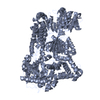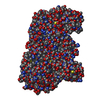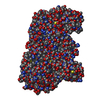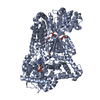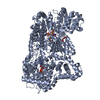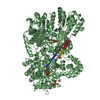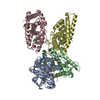+ Open data
Open data
- Basic information
Basic information
| Entry | Database: SASBDB / ID: SASDDM2 |
|---|---|
 Sample Sample | Sinorhizobium meliloti Proline Utilization A (PutA) at 2.00 mg/ml
|
| Function / homology |  Function and homology information Function and homology informationproline dehydrogenase / proline dehydrogenase activity / L-glutamate gamma-semialdehyde dehydrogenase / L-glutamate gamma-semialdehyde dehydrogenase activity / L-proline catabolic process to L-glutamate / : / cytoplasmic side of plasma membrane / DNA-binding transcription factor activity / nucleotide binding / DNA binding Similarity search - Function |
| Biological species |  Sinorhizobium meliloti (bacteria) Sinorhizobium meliloti (bacteria) |
 Citation Citation |  Journal: J Biol Chem / Year: 2016 Journal: J Biol Chem / Year: 2016Title: Structures of Proline Utilization A (PutA) Reveal the Fold and Functions of the Aldehyde Dehydrogenase Superfamily Domain of Unknown Function. Authors: Min Luo / Thameesha T Gamage / Benjamin W Arentson / Katherine N Schlasner / Donald F Becker / John J Tanner /  Abstract: Aldehyde dehydrogenases (ALDHs) catalyze the NAD(P)-dependent oxidation of aldehydes to carboxylic acids and are important for metabolism and detoxification. Although the ALDH superfamily fold is ...Aldehyde dehydrogenases (ALDHs) catalyze the NAD(P)-dependent oxidation of aldehydes to carboxylic acids and are important for metabolism and detoxification. Although the ALDH superfamily fold is well established, some ALDHs contain an uncharacterized domain of unknown function (DUF) near the C terminus of the polypeptide chain. Herein, we report the first structure of a protein containing the ALDH superfamily DUF. Proline utilization A from Sinorhizobium meliloti (SmPutA) is a 1233-residue bifunctional enzyme that contains the DUF in addition to proline dehydrogenase and l-glutamate-γ-semialdehyde dehydrogenase catalytic modules. Structures of SmPutA with a proline analog bound to the proline dehydrogenase site and NAD bound to the ALDH site were determined in two space groups at 1.7-1.9 Å resolution. The DUF consists of a Rossmann dinucleotide-binding fold fused to a three-stranded β-flap. The Rossmann domain resembles the classic ALDH superfamily NAD-binding domain, whereas the flap is strikingly similar to the ALDH superfamily dimerization domain. Paradoxically, neither structural element performs its implied function. Electron density maps show that NAD does not bind to the DUF Rossmann fold, and small-angle X-ray scattering reveals a novel dimer that has never been seen in the ALDH superfamily. The structure suggests that the DUF is an adapter domain that stabilizes the aldehyde substrate binding loop and seals the substrate-channeling tunnel via tertiary structural interactions that mimic the quaternary structural interactions found in non-DUF PutAs. Kinetic data for SmPutA indicate a substrate-channeling mechanism, in agreement with previous studies of other PutAs. |
 Contact author Contact author |
|
- Structure visualization
Structure visualization
| Structure viewer | Molecule:  Molmil Molmil Jmol/JSmol Jmol/JSmol |
|---|
- Downloads & links
Downloads & links
-Data source
| SASBDB page |  SASDDM2 SASDDM2 |
|---|
-Related structure data
- External links
External links
| Related items in Molecule of the Month |
|---|
-Models
| Model #1718 |  Type: mix / Radius of dummy atoms: 1.90 A / Chi-square value: 1.1879015356  Search similar-shape structures of this assembly by Omokage search (details) Search similar-shape structures of this assembly by Omokage search (details) |
|---|---|
| Model #1719 |  Type: mix / Radius of dummy atoms: 1.90 A / Chi-square value: 1.1879015356  Search similar-shape structures of this assembly by Omokage search (details) Search similar-shape structures of this assembly by Omokage search (details) |
- Sample
Sample
 Sample Sample | Name: Sinorhizobium meliloti Proline Utilization A (PutA) at 2.00 mg/ml Specimen concentration: 2 mg/ml |
|---|---|
| Buffer | Name: 50 mM Tris, 1% (v/v) glycerol, 0.5 mM THP, and 50 mM NaCl pH: 7.8 |
| Entity #933 | Name: SmPutA / Type: protein / Description: Sinorhizobium meliloti (SmPutA) / Formula weight: 131.805 / Num. of mol.: 1 / Source: Sinorhizobium meliloti / References: UniProt: F7X6I3 Sequence: SMMSPNPLQK PAIDAAPAPF ADFAPPVRPQ STLRRAITAA YRRPETECLP PLVEAATQSK EIRDAAASTA RKLIEALRGK HSGSGVEGLV QEYSLSSQEG VALMCLAEAL LRIPDTATRD ALIRDKIADG NWKSHLGGSR SLFVNAATWG LVVTGKLTST VNDRSLAAAL ...Sequence: SMMSPNPLQK PAIDAAPAPF ADFAPPVRPQ STLRRAITAA YRRPETECLP PLVEAATQSK EIRDAAASTA RKLIEALRGK HSGSGVEGLV QEYSLSSQEG VALMCLAEAL LRIPDTATRD ALIRDKIADG NWKSHLGGSR SLFVNAATWG LVVTGKLTST VNDRSLAAAL TRLISRCGEP VIRRGVDMAM RMMGEQFVTG ETIREALKRS KELEEKGFSY SYDMLGEAAT TAADAERYYR DYESAIHAIG KASAGRGIYE GPGISIKLSA LHPRYSRAQA ARVMGELLPR VKALALLAKN YDIGLNIDAE EADRLELSLD LLEVLCLDGD LSGWNGMGFV VQAYGKRCPF VLDFIIDLAR RSGRRIMVRL VKGAYWDAEI KRAQLDGLAD FPVFTRKIHT DVSYIACAAK LLAATDVVFP QFATHNAQTL AAIYHMAGKD FHVGKYEFQC LHGMGEPLYE EVVGRGKLDR PCRIYAPVGT HETLLAYLVR RLLENGANSS FVHRINDPKV SIDELIADPV EVVRAMPVVG AKHDRIALPA ELFGDARTNS AGLDLSNEET LASLTEALRE SAAMKWTALP QLATGPAAGE TRTVLNPGDH RDVVGSVTET SEEDARRAVR LAADAAPDWA AVPPSERAAC LDRAAELMQA RMPTLLGLII REAGKSALNA IAEVREAIDF LRYYAEQTRR TLGPGHGPLG PIVCISPWNF PLAIFTGQIA AALVAGNPVL AKPAEETPLI AAEGVRILRE AGIPASALQL LPGDGRVGAA LVAAAETAGV MFTGSTEVAR LIQAQLADRL SPAGRPIPLI AETGGQNAMI VDSSALAEQV VGDVITSAFD SAGQRCSALR VLCLQEDVAD RILTMLKGAL HELHIGRTDR LSVDVGPVIT SEAKDNIEKH IERMRGLGRK VEQIGLASET GVGTFVPPTI IELEKLSDLQ REVFGPVLHV IRYRRDDLDR LVDDVNATGY GLTFGLHTRL DETIAHVTSR IKAGNLYINR NIIGAVVGVQ PFGGRGLSGT GPKAGGPLYL GRLVTTAPVP PQHSSVHTDP VLLDFAKWLD GKGARAEAEA ARNAGSSSAL GLDLELPGPV GERNLYTLHA RGRILLVPAT ESGLYHQLAA ALATGNSVAI DAASGLQASL KNLPQTVGLR VSWSKDWAAD GPFAGALVEG DAERIRAVNK AIAALPGPLL LVQAASSGEI ARNPDAYCLN WLVEEVSASI NTAAAGGNAS LMAIG |
-Experimental information
| Beam | Instrument name: Advanced Light Source (ALS) 12.3.1 (SIBYLS) City: Berkeley, CA / 国: USA  / Type of source: X-ray synchrotron / Wavelength: 0.1127 Å / Type of source: X-ray synchrotron / Wavelength: 0.1127 Å | ||||||||||||||||||||||||||||||
|---|---|---|---|---|---|---|---|---|---|---|---|---|---|---|---|---|---|---|---|---|---|---|---|---|---|---|---|---|---|---|---|
| Detector | Name: MAR 165 CCD | ||||||||||||||||||||||||||||||
| Scan | Measurement date: Mar 27, 2014 / Cell temperature: 10 °C / Unit: 1/A /
| ||||||||||||||||||||||||||||||
| Distance distribution function P(R) |
| ||||||||||||||||||||||||||||||
| Result | Comments: The fit to the SAXS data is shown for a volume-fraction weighted mixture of monomers and dimers. The volume fraction of monomer and dimer are 0.73 and 0.27, respectively.
|
 Movie
Movie Controller
Controller


